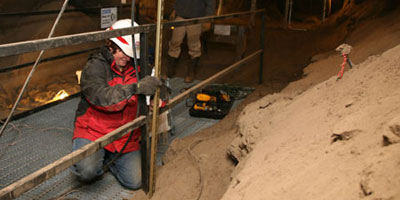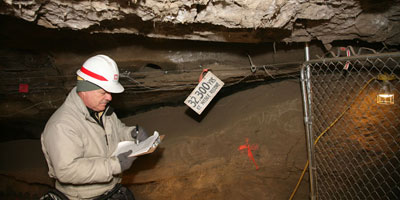The Permafrost Tunnel is situated near the valley floor of Goldstream Creek, 16 miles north of Fairbanks in Fox, Alaska (see the Location page). Although permafrost distribution in the region is discontinuous, the area near the confluence of Goldstream and Glenn Creeks provided continuous permafrost for the excavation of the tunnel.

The entrance to the tunnel.
Schematic of the tunnel.
The Permafrost Tunnel was excavated into a man-made escarpment, and is approximately 110 meters in length, 2 to 2.5 meters high, 4 to 5 meters wide, and 15 meters below the surface. The tunnel is composed of two portions: the adit (horizontal passage), which passes entirely through frozen silts, and the winze (inclined adit), which extends off of one side down 45 meters passing through silts, a gravel layer, and then into bedrock. The bottom of the winze is approximately 5 meters lower than the adit. Further descriptions of the permafrost soil types in the adit and winze can be found in the Geology section.

 Engineers originally used the tunnel to evaluate underground excavation techniques in permafrost. The adit was excavated using an Alkirk continuous-cycle miner machine during the winters of 1963–1964, 1964–1965, and 1965–1966. The winze was excavated in 1968-1969 by the U.S. Bureau of Mines to evaluate mining techniques in permafrost. Please see the Excavation Methods section for a detailed description of the techniques used in making the tunnel.
Engineers originally used the tunnel to evaluate underground excavation techniques in permafrost. The adit was excavated using an Alkirk continuous-cycle miner machine during the winters of 1963–1964, 1964–1965, and 1965–1966. The winze was excavated in 1968-1969 by the U.S. Bureau of Mines to evaluate mining techniques in permafrost. Please see the Excavation Methods section for a detailed description of the techniques used in making the tunnel.
It was during the excavation process that the tunnel's usefulness as a natural laboratory for natural science and engineering study became clear. The tunnel's frozen walls expose a continuous cross section of undisturbed, perennially frozen, fossil-rich silt, sand, and gravel on top of bedrock. Please see the Soil and Rock section.
Also exposed in the tunnel are a variety of ground ice types, including ice wedges, thermokarst cave ice, and ice lenses, each described further in the Cryostructures section.
Visible throughout the permafrost are a diverse assemblage of animal fossils and plant remains. Beatles, mites, flies, moths, butterflies, and snail shells are all frozen in time. Bones and teeth of bison, mammoth, and horse are among the vertebrate fossils that are visible. Further descriptions and images of the fossils can be found in the Paleontology section.
To maintain the frozen condition of the tunnel it is chilled in two ways: in the summer a refrigeration system cools the inside, and in the winter the cold outside ambient air is blown in. See the Keeping It Frozen page.
Today the Permafrost Tunnel is an active underground laboratory available for a variety of research programs. Each year, CRREL welcomes many research scientists and engineers interested in conducting research on the processes and properties of frozen soils. Please visit the Research section.